If you want your procurement department to be best in class in today’s competitive environment, you must build the perfect procurement process. Due to the significant spend seen in procurement, making improvements in your procurement performance is critical to enhancing your overall financial performance. Reducing your procurement spend slightly can actually be significant to your bottom line. However, achieving this requires you to change your outlook and utilize new strategies to build a better procurement process.
Here are five strategies that can help.
1. Define and Measure Your Objectives
How will you know if your procurement process is successful if you don’t define and measure objectives? This fundamental building block must occur. Once you clearly define your goals and objectives, you can then implement performance measures that will allow you to understand whether your process is working. You should be reviewing and updating these objectives as well as the methods used to measure them on a regular basis. Monthly reviews, in particular, can help you react to performance issues early so you can stay on track with your annual targets.
2. Increase Transparency
You cannot track or measure your activities or identify and resolve issues if you can’t see them. Increasing visibility and transparency will allow you to gain access to insightful data that you can use for the betterment of your procurement process. Breaking down your procurement activities by category and performing a spend analysis can give you the information you need to highlight opportunities for improvements and measure the results of your actions. Utilizing third-party solutions to increase transparency into your procurement operations might be necessary—it will allow for rapid deployment, improved quality of output, and a faster ROI.
3. Use the Right Technology
In today’s business world, organizations must utilize technology to achieve virtually any of their goals with the greatest efficiency and the lowest costs. There are commercial procurement software solutions available to help you enhance your procurement process. However, it’s important to select the right software program that effectively meets your needs, such as a program that can help you build on areas you need to improve or one that provides you with the type of data you need to make sound business decisions. When you choose the right technology, you’ll gain the greatest benefits.
4. Use Formal Contracts
Though small, one-time, or emergency purchases may not require the use of formal contracts, the majority of your total spend—at least eighty percent of it—should be under contract. Putting requirements and expectations in a legally binding document will allow you to hold your suppliers accountable for inadequate service levels and ensure that you’re only receiving top quality. Putting it in writing will help you minimize risks and liabilities and protect your organization.
5. Calculate Both Types of Return on Investment
The perfect procurement process takes into account more than just the best price. To stay ahead of the curve, you should be measuring an ROI that many organizations forget about: the non-financial value generated by a purchase.
Making an ROI calculation to assess the sales boost and savings against a purchase price can be done with a formula, but the non-financial benefits are more difficult to measure because you cannot express them through numbers. You need to understand how the purchase will make your company better off.
For example, if a new software program you procure frees up your sales people to talk to more prospects, you benefit. If procuring a certain product from a supplier leads to a higher customer satisfaction rate, you benefit from increased loyalty. If the procurement of ergonomic chairs for your office clerks leads to reduced stress and back pain, you benefit from increased productivity and morale. Considering these non-financial advantages as part of your procurement process, instead of just focusing on price, can lead to better results.



